Analysis of Engineering Behavior: Clay Reinforced with Cocopeat
VerifiedAdded on 2020/04/29
|13
|2915
|269
Report
AI Summary
This report investigates the engineering behavior of clay soil reinforced with cocopeat, a natural fiber derived from coconut husks. The research explores ground improvement methods, focusing on how cocopeat enhances the characteristics of clay soil. The literature review summarizes the consolidated impacts of cocopeat, examining its effects on the CBR value and strength of clayey soil through various experiments, including unconfined compression, direct shear box, and Tri-axial tests. The study also compares the performance of cocopeat with other reinforcement materials like human hair. Results indicate that cocopeat significantly improves soil strength, reduces settlement, and increases bearing capacity, making it a cost-effective and environmentally friendly solution for construction and engineering applications. The report provides detailed analysis of the experimental results, including consolidation curves and compression index, highlighting the optimal cocopeat content for maximizing soil performance.
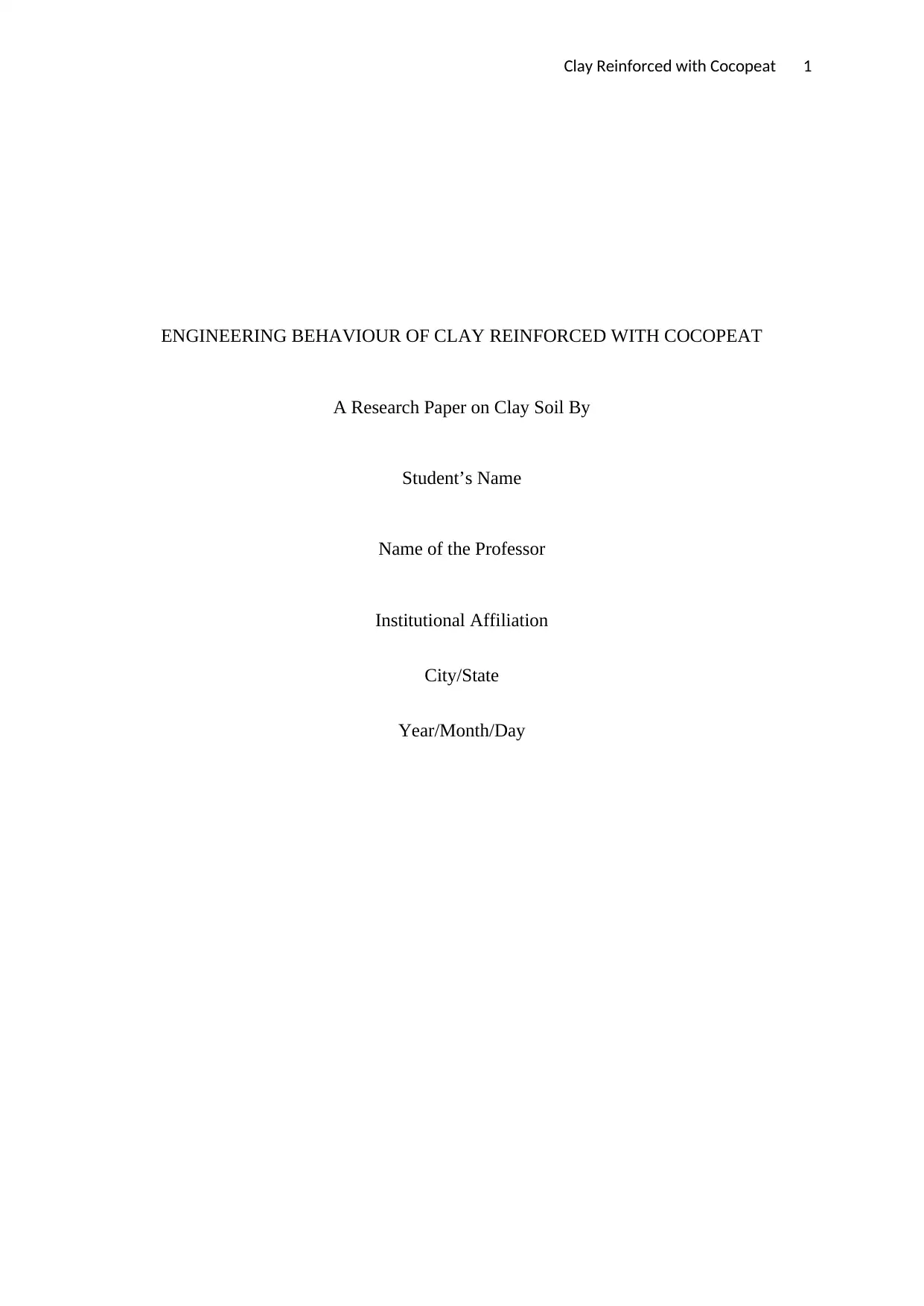
Clay Reinforced with Cocopeat 1
ENGINEERING BEHAVIOUR OF CLAY REINFORCED WITH COCOPEAT
A Research Paper on Clay Soil By
Student’s Name
Name of the Professor
Institutional Affiliation
City/State
Year/Month/Day
ENGINEERING BEHAVIOUR OF CLAY REINFORCED WITH COCOPEAT
A Research Paper on Clay Soil By
Student’s Name
Name of the Professor
Institutional Affiliation
City/State
Year/Month/Day
Paraphrase This Document
Need a fresh take? Get an instant paraphrase of this document with our AI Paraphraser
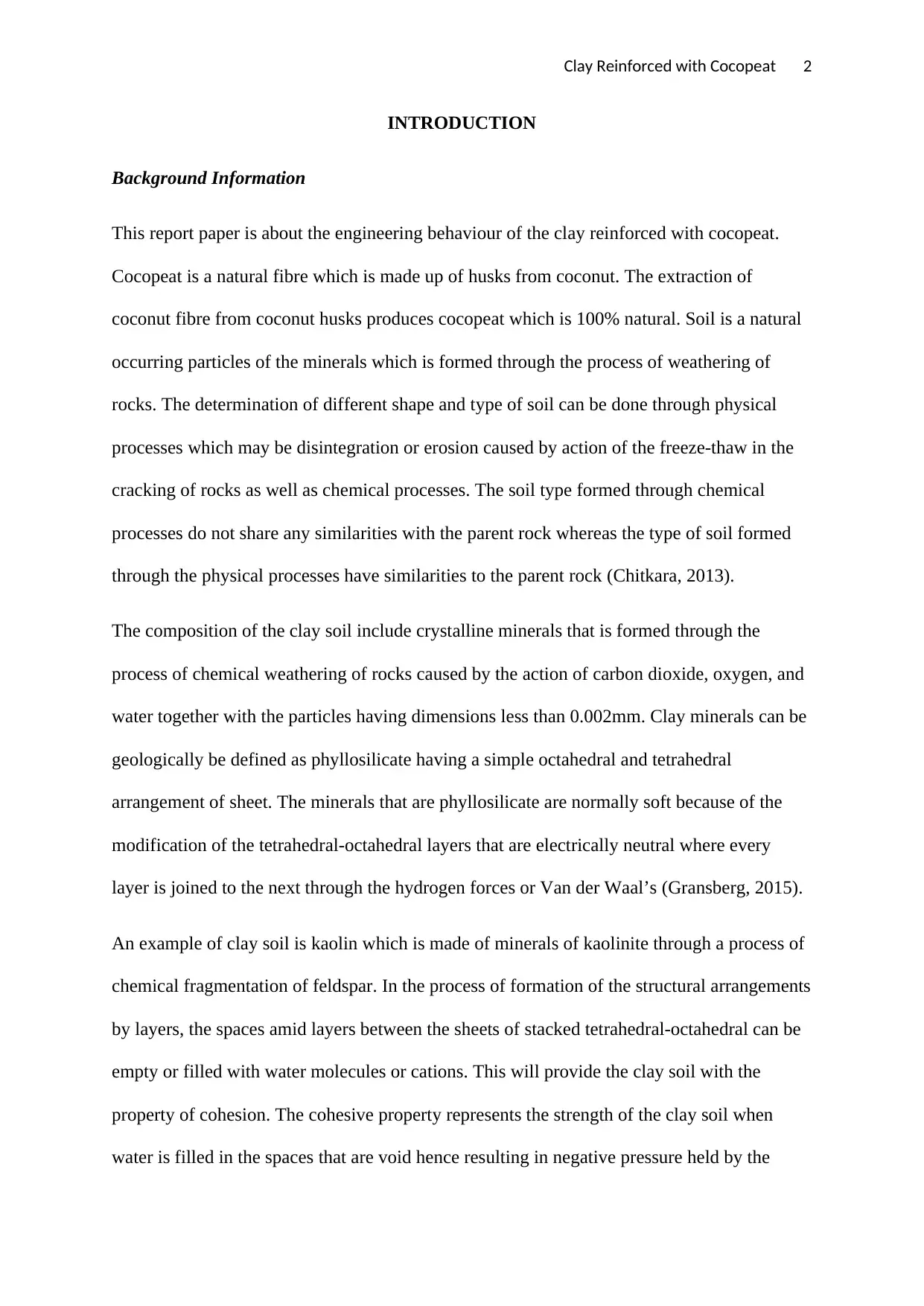
Clay Reinforced with Cocopeat 2
INTRODUCTION
Background Information
This report paper is about the engineering behaviour of the clay reinforced with cocopeat.
Cocopeat is a natural fibre which is made up of husks from coconut. The extraction of
coconut fibre from coconut husks produces cocopeat which is 100% natural. Soil is a natural
occurring particles of the minerals which is formed through the process of weathering of
rocks. The determination of different shape and type of soil can be done through physical
processes which may be disintegration or erosion caused by action of the freeze-thaw in the
cracking of rocks as well as chemical processes. The soil type formed through chemical
processes do not share any similarities with the parent rock whereas the type of soil formed
through the physical processes have similarities to the parent rock (Chitkara, 2013).
The composition of the clay soil include crystalline minerals that is formed through the
process of chemical weathering of rocks caused by the action of carbon dioxide, oxygen, and
water together with the particles having dimensions less than 0.002mm. Clay minerals can be
geologically be defined as phyllosilicate having a simple octahedral and tetrahedral
arrangement of sheet. The minerals that are phyllosilicate are normally soft because of the
modification of the tetrahedral-octahedral layers that are electrically neutral where every
layer is joined to the next through the hydrogen forces or Van der Waal’s (Gransberg, 2015).
An example of clay soil is kaolin which is made of minerals of kaolinite through a process of
chemical fragmentation of feldspar. In the process of formation of the structural arrangements
by layers, the spaces amid layers between the sheets of stacked tetrahedral-octahedral can be
empty or filled with water molecules or cations. This will provide the clay soil with the
property of cohesion. The cohesive property represents the strength of the clay soil when
water is filled in the spaces that are void hence resulting in negative pressure held by the
INTRODUCTION
Background Information
This report paper is about the engineering behaviour of the clay reinforced with cocopeat.
Cocopeat is a natural fibre which is made up of husks from coconut. The extraction of
coconut fibre from coconut husks produces cocopeat which is 100% natural. Soil is a natural
occurring particles of the minerals which is formed through the process of weathering of
rocks. The determination of different shape and type of soil can be done through physical
processes which may be disintegration or erosion caused by action of the freeze-thaw in the
cracking of rocks as well as chemical processes. The soil type formed through chemical
processes do not share any similarities with the parent rock whereas the type of soil formed
through the physical processes have similarities to the parent rock (Chitkara, 2013).
The composition of the clay soil include crystalline minerals that is formed through the
process of chemical weathering of rocks caused by the action of carbon dioxide, oxygen, and
water together with the particles having dimensions less than 0.002mm. Clay minerals can be
geologically be defined as phyllosilicate having a simple octahedral and tetrahedral
arrangement of sheet. The minerals that are phyllosilicate are normally soft because of the
modification of the tetrahedral-octahedral layers that are electrically neutral where every
layer is joined to the next through the hydrogen forces or Van der Waal’s (Gransberg, 2015).
An example of clay soil is kaolin which is made of minerals of kaolinite through a process of
chemical fragmentation of feldspar. In the process of formation of the structural arrangements
by layers, the spaces amid layers between the sheets of stacked tetrahedral-octahedral can be
empty or filled with water molecules or cations. This will provide the clay soil with the
property of cohesion. The cohesive property represents the strength of the clay soil when
water is filled in the spaces that are void hence resulting in negative pressure held by the
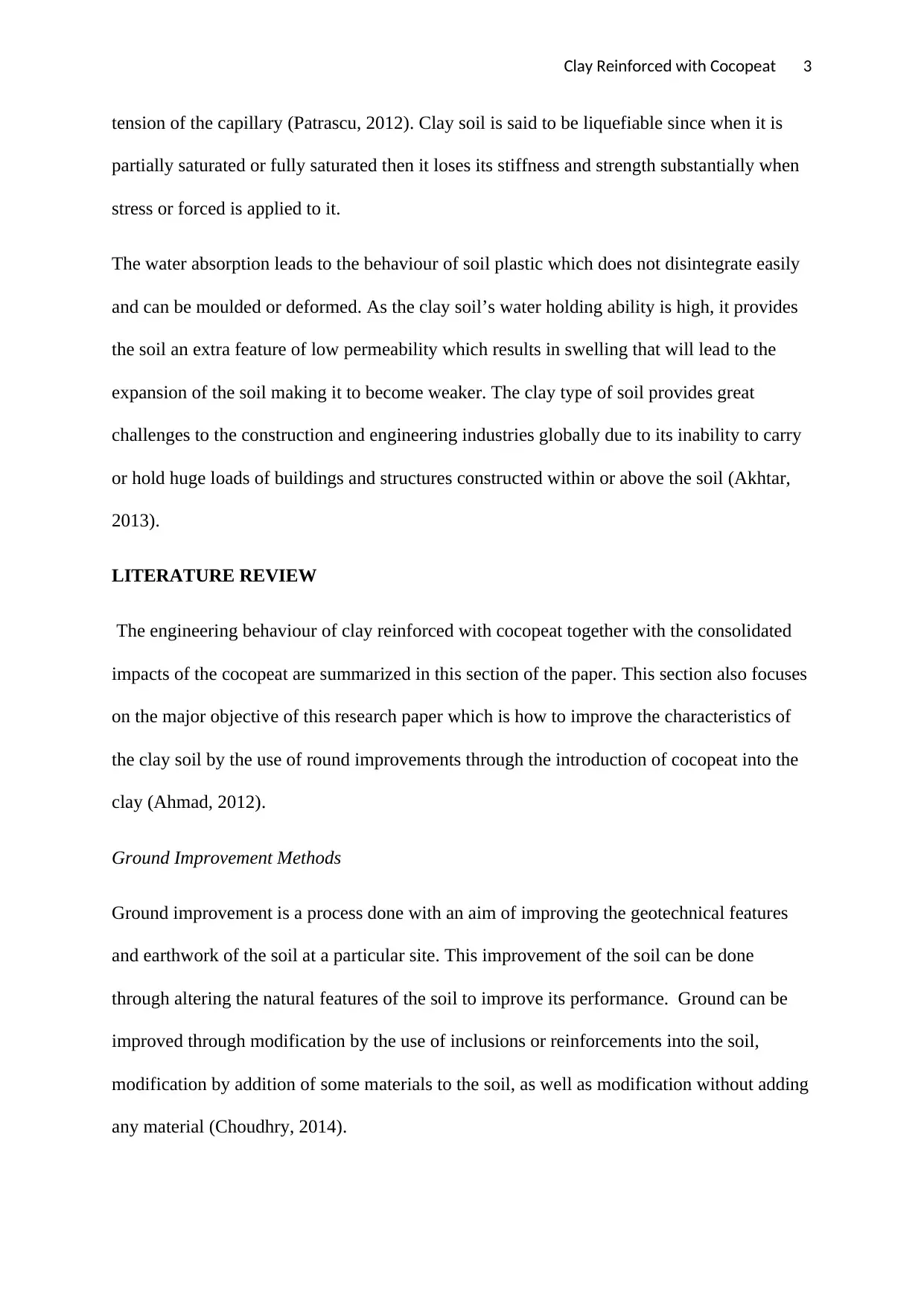
Clay Reinforced with Cocopeat 3
tension of the capillary (Patrascu, 2012). Clay soil is said to be liquefiable since when it is
partially saturated or fully saturated then it loses its stiffness and strength substantially when
stress or forced is applied to it.
The water absorption leads to the behaviour of soil plastic which does not disintegrate easily
and can be moulded or deformed. As the clay soil’s water holding ability is high, it provides
the soil an extra feature of low permeability which results in swelling that will lead to the
expansion of the soil making it to become weaker. The clay type of soil provides great
challenges to the construction and engineering industries globally due to its inability to carry
or hold huge loads of buildings and structures constructed within or above the soil (Akhtar,
2013).
LITERATURE REVIEW
The engineering behaviour of clay reinforced with cocopeat together with the consolidated
impacts of the cocopeat are summarized in this section of the paper. This section also focuses
on the major objective of this research paper which is how to improve the characteristics of
the clay soil by the use of round improvements through the introduction of cocopeat into the
clay (Ahmad, 2012).
Ground Improvement Methods
Ground improvement is a process done with an aim of improving the geotechnical features
and earthwork of the soil at a particular site. This improvement of the soil can be done
through altering the natural features of the soil to improve its performance. Ground can be
improved through modification by the use of inclusions or reinforcements into the soil,
modification by addition of some materials to the soil, as well as modification without adding
any material (Choudhry, 2014).
tension of the capillary (Patrascu, 2012). Clay soil is said to be liquefiable since when it is
partially saturated or fully saturated then it loses its stiffness and strength substantially when
stress or forced is applied to it.
The water absorption leads to the behaviour of soil plastic which does not disintegrate easily
and can be moulded or deformed. As the clay soil’s water holding ability is high, it provides
the soil an extra feature of low permeability which results in swelling that will lead to the
expansion of the soil making it to become weaker. The clay type of soil provides great
challenges to the construction and engineering industries globally due to its inability to carry
or hold huge loads of buildings and structures constructed within or above the soil (Akhtar,
2013).
LITERATURE REVIEW
The engineering behaviour of clay reinforced with cocopeat together with the consolidated
impacts of the cocopeat are summarized in this section of the paper. This section also focuses
on the major objective of this research paper which is how to improve the characteristics of
the clay soil by the use of round improvements through the introduction of cocopeat into the
clay (Ahmad, 2012).
Ground Improvement Methods
Ground improvement is a process done with an aim of improving the geotechnical features
and earthwork of the soil at a particular site. This improvement of the soil can be done
through altering the natural features of the soil to improve its performance. Ground can be
improved through modification by the use of inclusions or reinforcements into the soil,
modification by addition of some materials to the soil, as well as modification without adding
any material (Choudhry, 2014).
⊘ This is a preview!⊘
Do you want full access?
Subscribe today to unlock all pages.

Trusted by 1+ million students worldwide
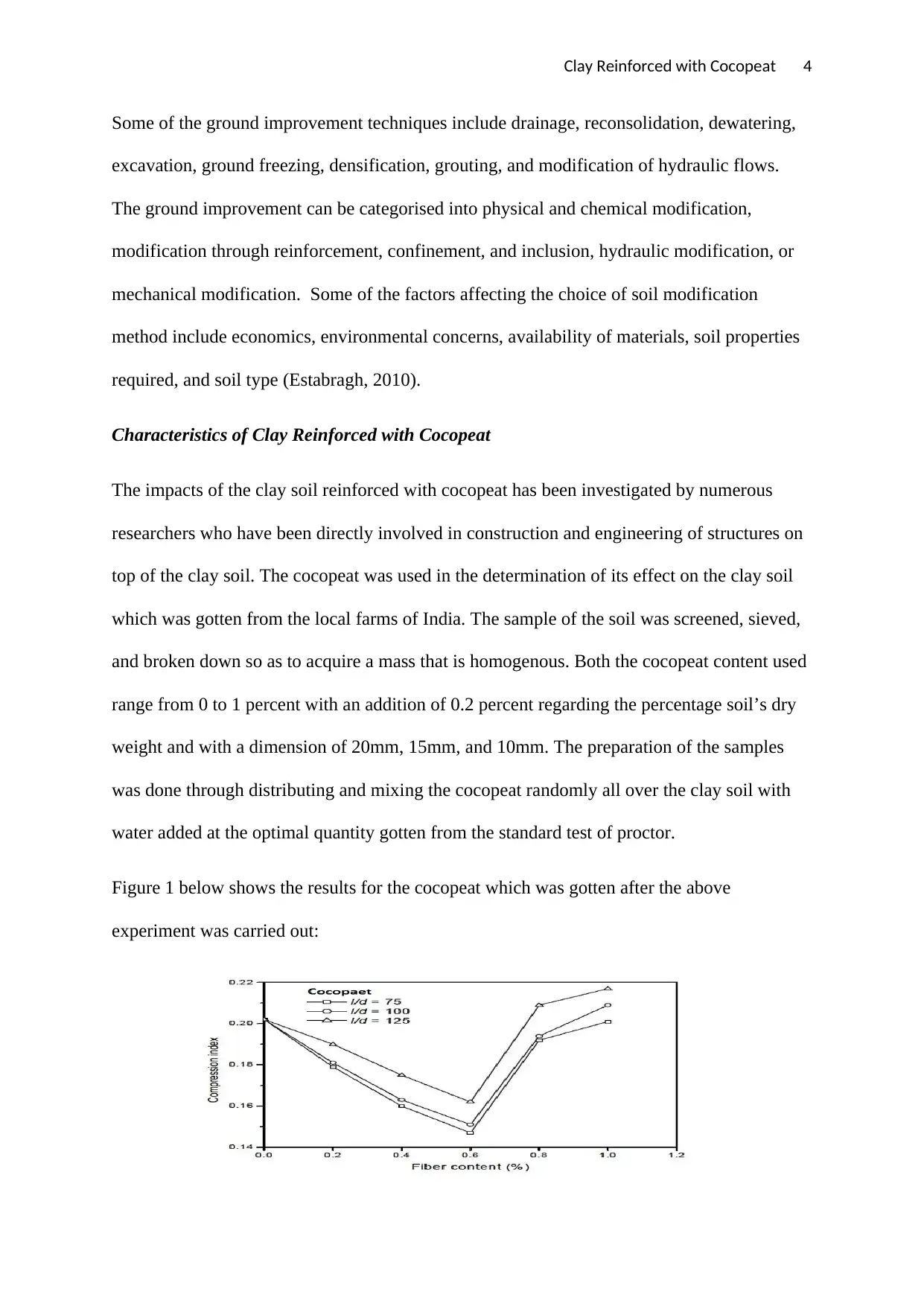
Clay Reinforced with Cocopeat 4
Some of the ground improvement techniques include drainage, reconsolidation, dewatering,
excavation, ground freezing, densification, grouting, and modification of hydraulic flows.
The ground improvement can be categorised into physical and chemical modification,
modification through reinforcement, confinement, and inclusion, hydraulic modification, or
mechanical modification. Some of the factors affecting the choice of soil modification
method include economics, environmental concerns, availability of materials, soil properties
required, and soil type (Estabragh, 2010).
Characteristics of Clay Reinforced with Cocopeat
The impacts of the clay soil reinforced with cocopeat has been investigated by numerous
researchers who have been directly involved in construction and engineering of structures on
top of the clay soil. The cocopeat was used in the determination of its effect on the clay soil
which was gotten from the local farms of India. The sample of the soil was screened, sieved,
and broken down so as to acquire a mass that is homogenous. Both the cocopeat content used
range from 0 to 1 percent with an addition of 0.2 percent regarding the percentage soil’s dry
weight and with a dimension of 20mm, 15mm, and 10mm. The preparation of the samples
was done through distributing and mixing the cocopeat randomly all over the clay soil with
water added at the optimal quantity gotten from the standard test of proctor.
Figure 1 below shows the results for the cocopeat which was gotten after the above
experiment was carried out:
Some of the ground improvement techniques include drainage, reconsolidation, dewatering,
excavation, ground freezing, densification, grouting, and modification of hydraulic flows.
The ground improvement can be categorised into physical and chemical modification,
modification through reinforcement, confinement, and inclusion, hydraulic modification, or
mechanical modification. Some of the factors affecting the choice of soil modification
method include economics, environmental concerns, availability of materials, soil properties
required, and soil type (Estabragh, 2010).
Characteristics of Clay Reinforced with Cocopeat
The impacts of the clay soil reinforced with cocopeat has been investigated by numerous
researchers who have been directly involved in construction and engineering of structures on
top of the clay soil. The cocopeat was used in the determination of its effect on the clay soil
which was gotten from the local farms of India. The sample of the soil was screened, sieved,
and broken down so as to acquire a mass that is homogenous. Both the cocopeat content used
range from 0 to 1 percent with an addition of 0.2 percent regarding the percentage soil’s dry
weight and with a dimension of 20mm, 15mm, and 10mm. The preparation of the samples
was done through distributing and mixing the cocopeat randomly all over the clay soil with
water added at the optimal quantity gotten from the standard test of proctor.
Figure 1 below shows the results for the cocopeat which was gotten after the above
experiment was carried out:
Paraphrase This Document
Need a fresh take? Get an instant paraphrase of this document with our AI Paraphraser
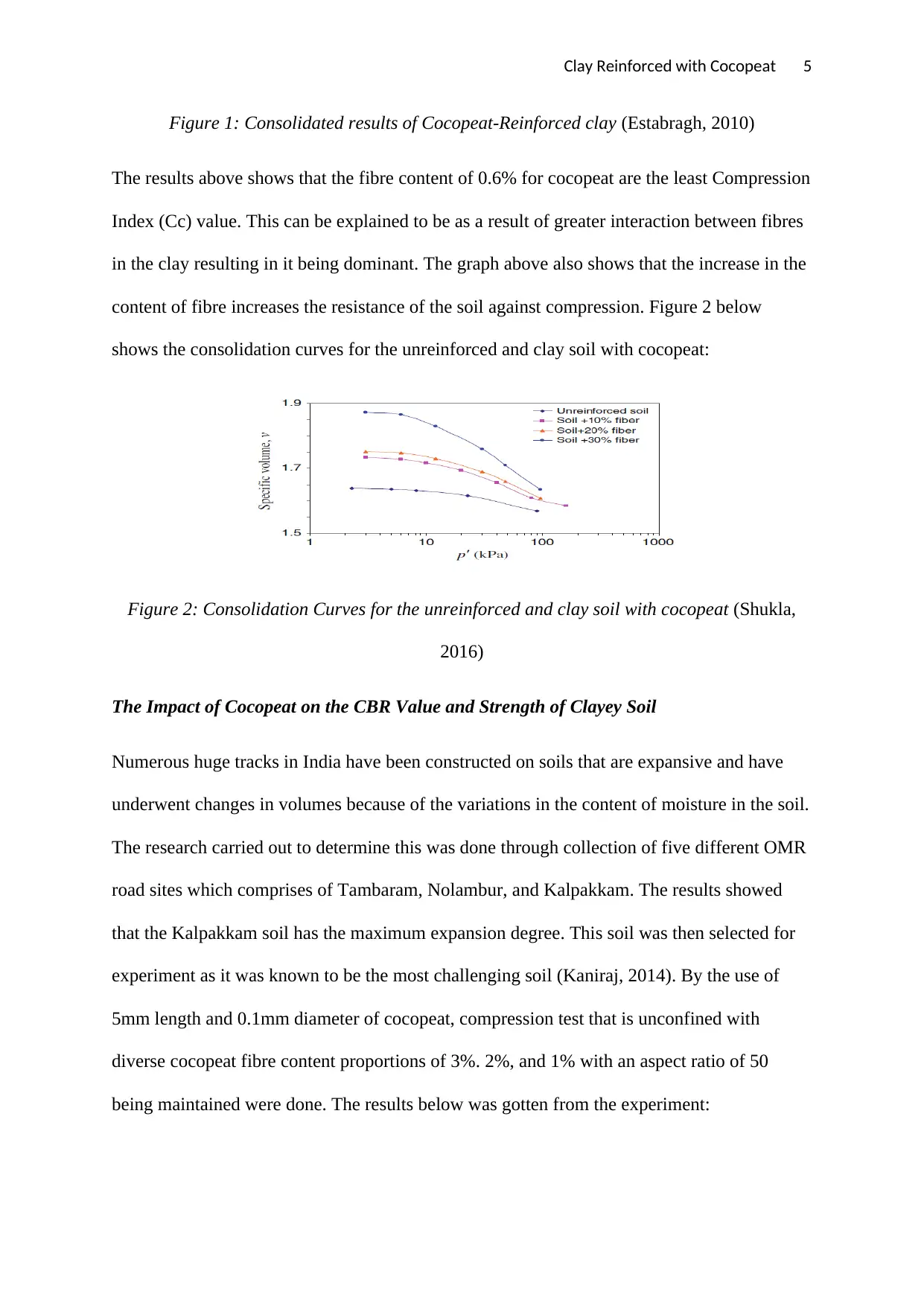
Clay Reinforced with Cocopeat 5
Figure 1: Consolidated results of Cocopeat-Reinforced clay (Estabragh, 2010)
The results above shows that the fibre content of 0.6% for cocopeat are the least Compression
Index (Cc) value. This can be explained to be as a result of greater interaction between fibres
in the clay resulting in it being dominant. The graph above also shows that the increase in the
content of fibre increases the resistance of the soil against compression. Figure 2 below
shows the consolidation curves for the unreinforced and clay soil with cocopeat:
Figure 2: Consolidation Curves for the unreinforced and clay soil with cocopeat (Shukla,
2016)
The Impact of Cocopeat on the CBR Value and Strength of Clayey Soil
Numerous huge tracks in India have been constructed on soils that are expansive and have
underwent changes in volumes because of the variations in the content of moisture in the soil.
The research carried out to determine this was done through collection of five different OMR
road sites which comprises of Tambaram, Nolambur, and Kalpakkam. The results showed
that the Kalpakkam soil has the maximum expansion degree. This soil was then selected for
experiment as it was known to be the most challenging soil (Kaniraj, 2014). By the use of
5mm length and 0.1mm diameter of cocopeat, compression test that is unconfined with
diverse cocopeat fibre content proportions of 3%. 2%, and 1% with an aspect ratio of 50
being maintained were done. The results below was gotten from the experiment:
Figure 1: Consolidated results of Cocopeat-Reinforced clay (Estabragh, 2010)
The results above shows that the fibre content of 0.6% for cocopeat are the least Compression
Index (Cc) value. This can be explained to be as a result of greater interaction between fibres
in the clay resulting in it being dominant. The graph above also shows that the increase in the
content of fibre increases the resistance of the soil against compression. Figure 2 below
shows the consolidation curves for the unreinforced and clay soil with cocopeat:
Figure 2: Consolidation Curves for the unreinforced and clay soil with cocopeat (Shukla,
2016)
The Impact of Cocopeat on the CBR Value and Strength of Clayey Soil
Numerous huge tracks in India have been constructed on soils that are expansive and have
underwent changes in volumes because of the variations in the content of moisture in the soil.
The research carried out to determine this was done through collection of five different OMR
road sites which comprises of Tambaram, Nolambur, and Kalpakkam. The results showed
that the Kalpakkam soil has the maximum expansion degree. This soil was then selected for
experiment as it was known to be the most challenging soil (Kaniraj, 2014). By the use of
5mm length and 0.1mm diameter of cocopeat, compression test that is unconfined with
diverse cocopeat fibre content proportions of 3%. 2%, and 1% with an aspect ratio of 50
being maintained were done. The results below was gotten from the experiment:
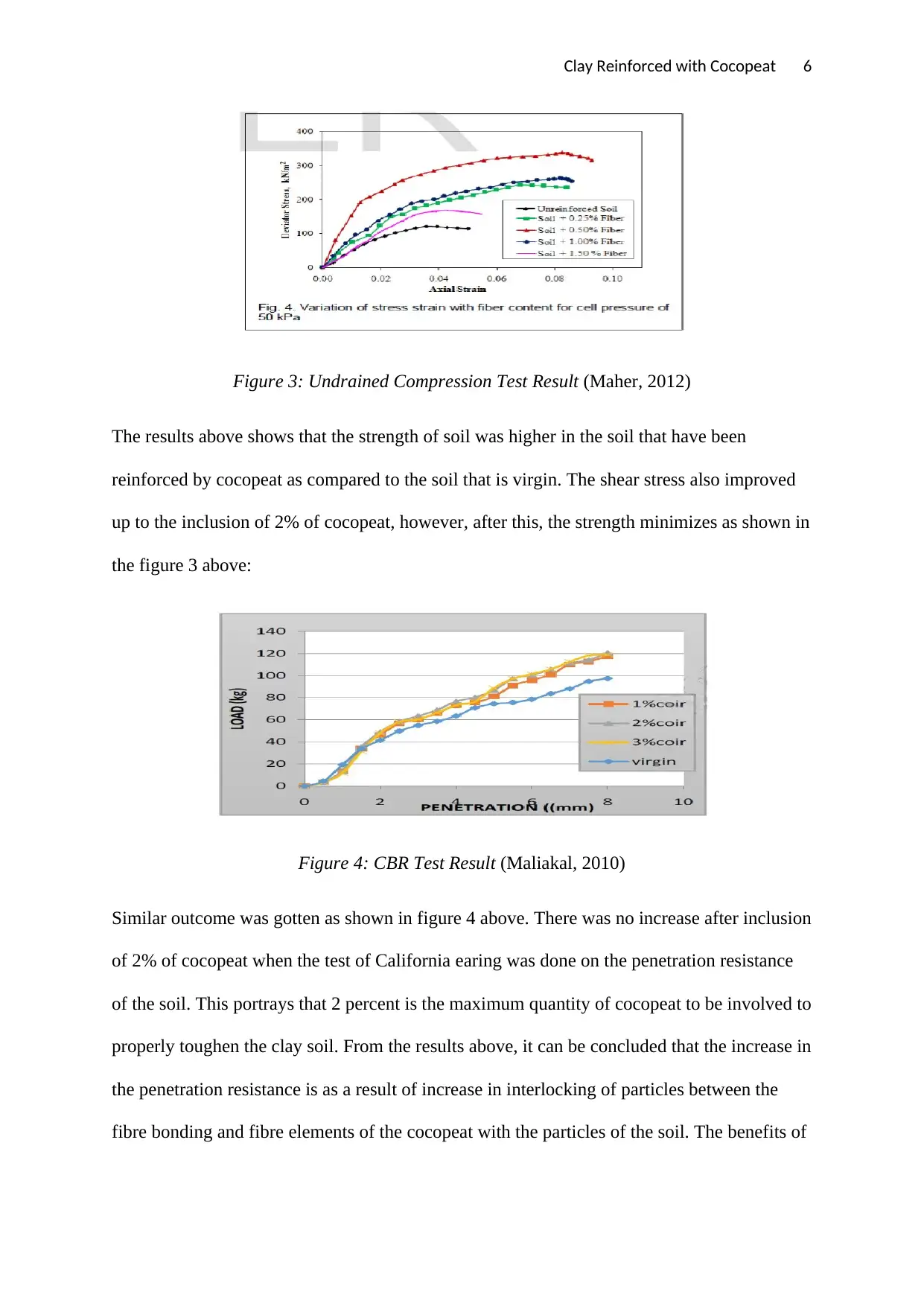
Clay Reinforced with Cocopeat 6
Figure 3: Undrained Compression Test Result (Maher, 2012)
The results above shows that the strength of soil was higher in the soil that have been
reinforced by cocopeat as compared to the soil that is virgin. The shear stress also improved
up to the inclusion of 2% of cocopeat, however, after this, the strength minimizes as shown in
the figure 3 above:
Figure 4: CBR Test Result (Maliakal, 2010)
Similar outcome was gotten as shown in figure 4 above. There was no increase after inclusion
of 2% of cocopeat when the test of California earing was done on the penetration resistance
of the soil. This portrays that 2 percent is the maximum quantity of cocopeat to be involved to
properly toughen the clay soil. From the results above, it can be concluded that the increase in
the penetration resistance is as a result of increase in interlocking of particles between the
fibre bonding and fibre elements of the cocopeat with the particles of the soil. The benefits of
Figure 3: Undrained Compression Test Result (Maher, 2012)
The results above shows that the strength of soil was higher in the soil that have been
reinforced by cocopeat as compared to the soil that is virgin. The shear stress also improved
up to the inclusion of 2% of cocopeat, however, after this, the strength minimizes as shown in
the figure 3 above:
Figure 4: CBR Test Result (Maliakal, 2010)
Similar outcome was gotten as shown in figure 4 above. There was no increase after inclusion
of 2% of cocopeat when the test of California earing was done on the penetration resistance
of the soil. This portrays that 2 percent is the maximum quantity of cocopeat to be involved to
properly toughen the clay soil. From the results above, it can be concluded that the increase in
the penetration resistance is as a result of increase in interlocking of particles between the
fibre bonding and fibre elements of the cocopeat with the particles of the soil. The benefits of
⊘ This is a preview!⊘
Do you want full access?
Subscribe today to unlock all pages.

Trusted by 1+ million students worldwide
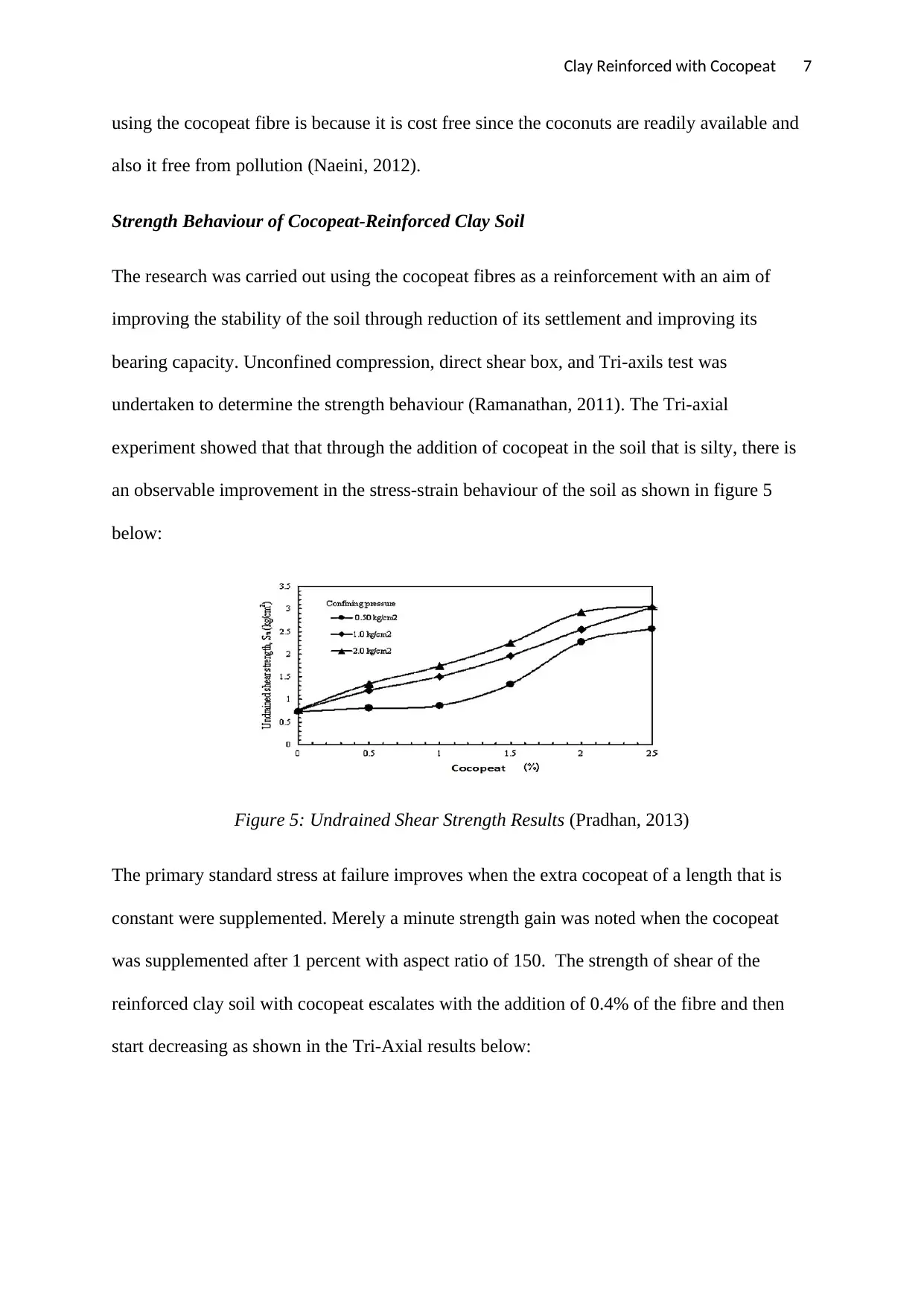
Clay Reinforced with Cocopeat 7
using the cocopeat fibre is because it is cost free since the coconuts are readily available and
also it free from pollution (Naeini, 2012).
Strength Behaviour of Cocopeat-Reinforced Clay Soil
The research was carried out using the cocopeat fibres as a reinforcement with an aim of
improving the stability of the soil through reduction of its settlement and improving its
bearing capacity. Unconfined compression, direct shear box, and Tri-axils test was
undertaken to determine the strength behaviour (Ramanathan, 2011). The Tri-axial
experiment showed that that through the addition of cocopeat in the soil that is silty, there is
an observable improvement in the stress-strain behaviour of the soil as shown in figure 5
below:
Figure 5: Undrained Shear Strength Results (Pradhan, 2013)
The primary standard stress at failure improves when the extra cocopeat of a length that is
constant were supplemented. Merely a minute strength gain was noted when the cocopeat
was supplemented after 1 percent with aspect ratio of 150. The strength of shear of the
reinforced clay soil with cocopeat escalates with the addition of 0.4% of the fibre and then
start decreasing as shown in the Tri-Axial results below:
using the cocopeat fibre is because it is cost free since the coconuts are readily available and
also it free from pollution (Naeini, 2012).
Strength Behaviour of Cocopeat-Reinforced Clay Soil
The research was carried out using the cocopeat fibres as a reinforcement with an aim of
improving the stability of the soil through reduction of its settlement and improving its
bearing capacity. Unconfined compression, direct shear box, and Tri-axils test was
undertaken to determine the strength behaviour (Ramanathan, 2011). The Tri-axial
experiment showed that that through the addition of cocopeat in the soil that is silty, there is
an observable improvement in the stress-strain behaviour of the soil as shown in figure 5
below:
Figure 5: Undrained Shear Strength Results (Pradhan, 2013)
The primary standard stress at failure improves when the extra cocopeat of a length that is
constant were supplemented. Merely a minute strength gain was noted when the cocopeat
was supplemented after 1 percent with aspect ratio of 150. The strength of shear of the
reinforced clay soil with cocopeat escalates with the addition of 0.4% of the fibre and then
start decreasing as shown in the Tri-Axial results below:
Paraphrase This Document
Need a fresh take? Get an instant paraphrase of this document with our AI Paraphraser
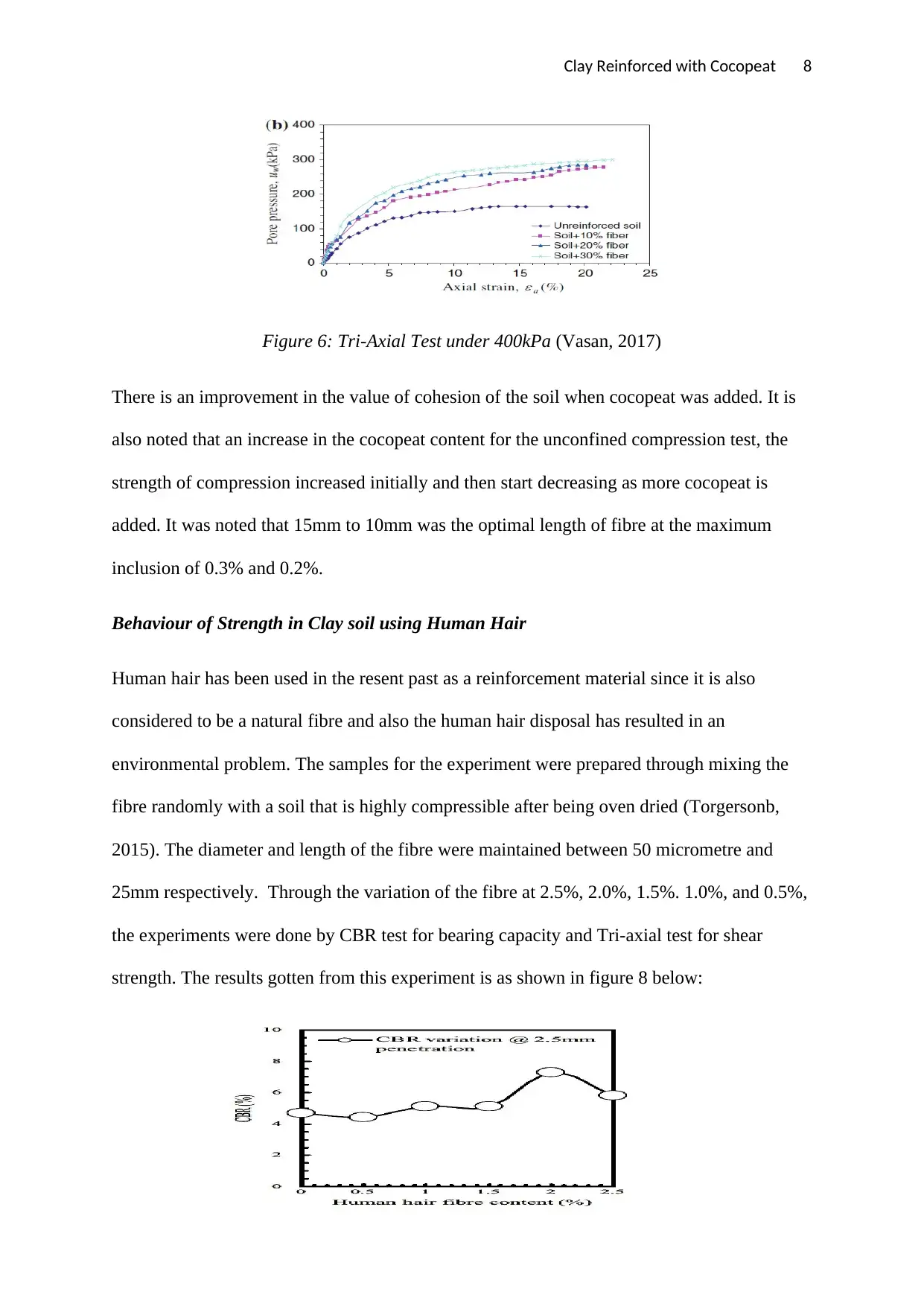
Clay Reinforced with Cocopeat 8
Figure 6: Tri-Axial Test under 400kPa (Vasan, 2017)
There is an improvement in the value of cohesion of the soil when cocopeat was added. It is
also noted that an increase in the cocopeat content for the unconfined compression test, the
strength of compression increased initially and then start decreasing as more cocopeat is
added. It was noted that 15mm to 10mm was the optimal length of fibre at the maximum
inclusion of 0.3% and 0.2%.
Behaviour of Strength in Clay soil using Human Hair
Human hair has been used in the resent past as a reinforcement material since it is also
considered to be a natural fibre and also the human hair disposal has resulted in an
environmental problem. The samples for the experiment were prepared through mixing the
fibre randomly with a soil that is highly compressible after being oven dried (Torgersonb,
2015). The diameter and length of the fibre were maintained between 50 micrometre and
25mm respectively. Through the variation of the fibre at 2.5%, 2.0%, 1.5%. 1.0%, and 0.5%,
the experiments were done by CBR test for bearing capacity and Tri-axial test for shear
strength. The results gotten from this experiment is as shown in figure 8 below:
Figure 6: Tri-Axial Test under 400kPa (Vasan, 2017)
There is an improvement in the value of cohesion of the soil when cocopeat was added. It is
also noted that an increase in the cocopeat content for the unconfined compression test, the
strength of compression increased initially and then start decreasing as more cocopeat is
added. It was noted that 15mm to 10mm was the optimal length of fibre at the maximum
inclusion of 0.3% and 0.2%.
Behaviour of Strength in Clay soil using Human Hair
Human hair has been used in the resent past as a reinforcement material since it is also
considered to be a natural fibre and also the human hair disposal has resulted in an
environmental problem. The samples for the experiment were prepared through mixing the
fibre randomly with a soil that is highly compressible after being oven dried (Torgersonb,
2015). The diameter and length of the fibre were maintained between 50 micrometre and
25mm respectively. Through the variation of the fibre at 2.5%, 2.0%, 1.5%. 1.0%, and 0.5%,
the experiments were done by CBR test for bearing capacity and Tri-axial test for shear
strength. The results gotten from this experiment is as shown in figure 8 below:
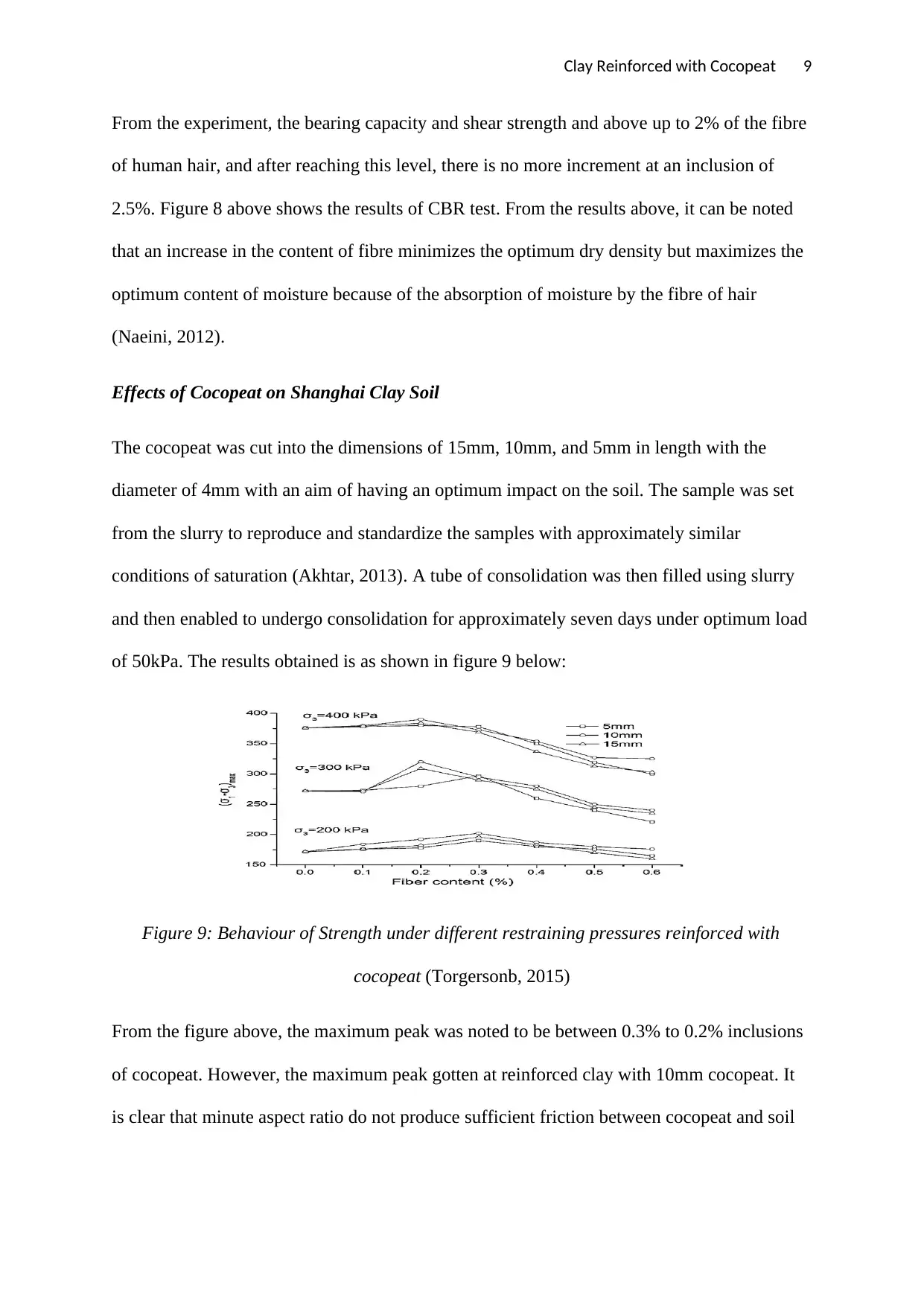
Clay Reinforced with Cocopeat 9
From the experiment, the bearing capacity and shear strength and above up to 2% of the fibre
of human hair, and after reaching this level, there is no more increment at an inclusion of
2.5%. Figure 8 above shows the results of CBR test. From the results above, it can be noted
that an increase in the content of fibre minimizes the optimum dry density but maximizes the
optimum content of moisture because of the absorption of moisture by the fibre of hair
(Naeini, 2012).
Effects of Cocopeat on Shanghai Clay Soil
The cocopeat was cut into the dimensions of 15mm, 10mm, and 5mm in length with the
diameter of 4mm with an aim of having an optimum impact on the soil. The sample was set
from the slurry to reproduce and standardize the samples with approximately similar
conditions of saturation (Akhtar, 2013). A tube of consolidation was then filled using slurry
and then enabled to undergo consolidation for approximately seven days under optimum load
of 50kPa. The results obtained is as shown in figure 9 below:
Figure 9: Behaviour of Strength under different restraining pressures reinforced with
cocopeat (Torgersonb, 2015)
From the figure above, the maximum peak was noted to be between 0.3% to 0.2% inclusions
of cocopeat. However, the maximum peak gotten at reinforced clay with 10mm cocopeat. It
is clear that minute aspect ratio do not produce sufficient friction between cocopeat and soil
From the experiment, the bearing capacity and shear strength and above up to 2% of the fibre
of human hair, and after reaching this level, there is no more increment at an inclusion of
2.5%. Figure 8 above shows the results of CBR test. From the results above, it can be noted
that an increase in the content of fibre minimizes the optimum dry density but maximizes the
optimum content of moisture because of the absorption of moisture by the fibre of hair
(Naeini, 2012).
Effects of Cocopeat on Shanghai Clay Soil
The cocopeat was cut into the dimensions of 15mm, 10mm, and 5mm in length with the
diameter of 4mm with an aim of having an optimum impact on the soil. The sample was set
from the slurry to reproduce and standardize the samples with approximately similar
conditions of saturation (Akhtar, 2013). A tube of consolidation was then filled using slurry
and then enabled to undergo consolidation for approximately seven days under optimum load
of 50kPa. The results obtained is as shown in figure 9 below:
Figure 9: Behaviour of Strength under different restraining pressures reinforced with
cocopeat (Torgersonb, 2015)
From the figure above, the maximum peak was noted to be between 0.3% to 0.2% inclusions
of cocopeat. However, the maximum peak gotten at reinforced clay with 10mm cocopeat. It
is clear that minute aspect ratio do not produce sufficient friction between cocopeat and soil
⊘ This is a preview!⊘
Do you want full access?
Subscribe today to unlock all pages.

Trusted by 1+ million students worldwide
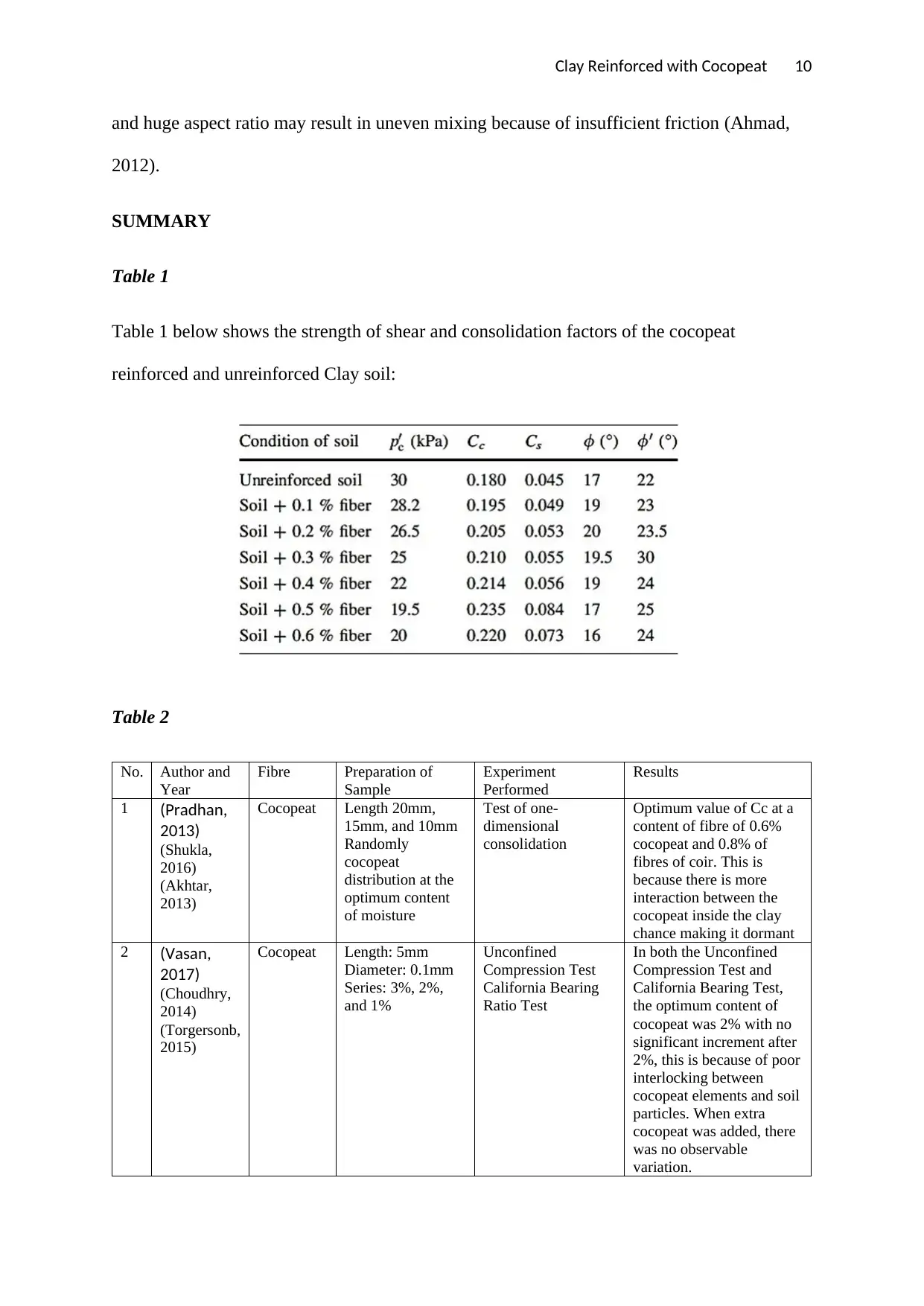
Clay Reinforced with Cocopeat 10
and huge aspect ratio may result in uneven mixing because of insufficient friction (Ahmad,
2012).
SUMMARY
Table 1
Table 1 below shows the strength of shear and consolidation factors of the cocopeat
reinforced and unreinforced Clay soil:
Table 2
No. Author and
Year
Fibre Preparation of
Sample
Experiment
Performed
Results
1 (Pradhan,
2013)
(Shukla,
2016)
(Akhtar,
2013)
Cocopeat Length 20mm,
15mm, and 10mm
Randomly
cocopeat
distribution at the
optimum content
of moisture
Test of one-
dimensional
consolidation
Optimum value of Cc at a
content of fibre of 0.6%
cocopeat and 0.8% of
fibres of coir. This is
because there is more
interaction between the
cocopeat inside the clay
chance making it dormant
2 (Vasan,
2017)
(Choudhry,
2014)
(Torgersonb,
2015)
Cocopeat Length: 5mm
Diameter: 0.1mm
Series: 3%, 2%,
and 1%
Unconfined
Compression Test
California Bearing
Ratio Test
In both the Unconfined
Compression Test and
California Bearing Test,
the optimum content of
cocopeat was 2% with no
significant increment after
2%, this is because of poor
interlocking between
cocopeat elements and soil
particles. When extra
cocopeat was added, there
was no observable
variation.
and huge aspect ratio may result in uneven mixing because of insufficient friction (Ahmad,
2012).
SUMMARY
Table 1
Table 1 below shows the strength of shear and consolidation factors of the cocopeat
reinforced and unreinforced Clay soil:
Table 2
No. Author and
Year
Fibre Preparation of
Sample
Experiment
Performed
Results
1 (Pradhan,
2013)
(Shukla,
2016)
(Akhtar,
2013)
Cocopeat Length 20mm,
15mm, and 10mm
Randomly
cocopeat
distribution at the
optimum content
of moisture
Test of one-
dimensional
consolidation
Optimum value of Cc at a
content of fibre of 0.6%
cocopeat and 0.8% of
fibres of coir. This is
because there is more
interaction between the
cocopeat inside the clay
chance making it dormant
2 (Vasan,
2017)
(Choudhry,
2014)
(Torgersonb,
2015)
Cocopeat Length: 5mm
Diameter: 0.1mm
Series: 3%, 2%,
and 1%
Unconfined
Compression Test
California Bearing
Ratio Test
In both the Unconfined
Compression Test and
California Bearing Test,
the optimum content of
cocopeat was 2% with no
significant increment after
2%, this is because of poor
interlocking between
cocopeat elements and soil
particles. When extra
cocopeat was added, there
was no observable
variation.
Paraphrase This Document
Need a fresh take? Get an instant paraphrase of this document with our AI Paraphraser

Clay Reinforced with Cocopeat 11
3 (Maher,
2012)
(Kaniraj,
2014)
(Naeini,
2012)
Cocopeat Series: 2.5%, 2%,
1.5%, 1%, 0.5%,
and 0%
Length: 20mm,
15mm, and 10mm
Direct shearbox test
Tri-axial Test
In direct shearbox test, the
cocopeat strength increases
up to inclusion of 0.4% at
20mm length and 100
aspect ratio was optimum
In Tri-axial test, the
increase in cocopeat
increases the primary
principle gain strength and
stress failure with 150
aspect ratio of the
cocopeat.
4 (Akhtar,
2013)
(Estabragh,
2010)
Human
Hair
Random fibre
distribution
prepared at
maximum content
of moisture and
maximum dry
weight of 95%
California Bearing
Ratio Test
Undrained Tri-axial
Test
The maximum content of
fibre is inclusion of 2%
An increase on fibre
minimized the optimum
dry weight, increases the
maximum content of
moisture.
This is because of human
hair moisture.
3 (Maher,
2012)
(Kaniraj,
2014)
(Naeini,
2012)
Cocopeat Series: 2.5%, 2%,
1.5%, 1%, 0.5%,
and 0%
Length: 20mm,
15mm, and 10mm
Direct shearbox test
Tri-axial Test
In direct shearbox test, the
cocopeat strength increases
up to inclusion of 0.4% at
20mm length and 100
aspect ratio was optimum
In Tri-axial test, the
increase in cocopeat
increases the primary
principle gain strength and
stress failure with 150
aspect ratio of the
cocopeat.
4 (Akhtar,
2013)
(Estabragh,
2010)
Human
Hair
Random fibre
distribution
prepared at
maximum content
of moisture and
maximum dry
weight of 95%
California Bearing
Ratio Test
Undrained Tri-axial
Test
The maximum content of
fibre is inclusion of 2%
An increase on fibre
minimized the optimum
dry weight, increases the
maximum content of
moisture.
This is because of human
hair moisture.
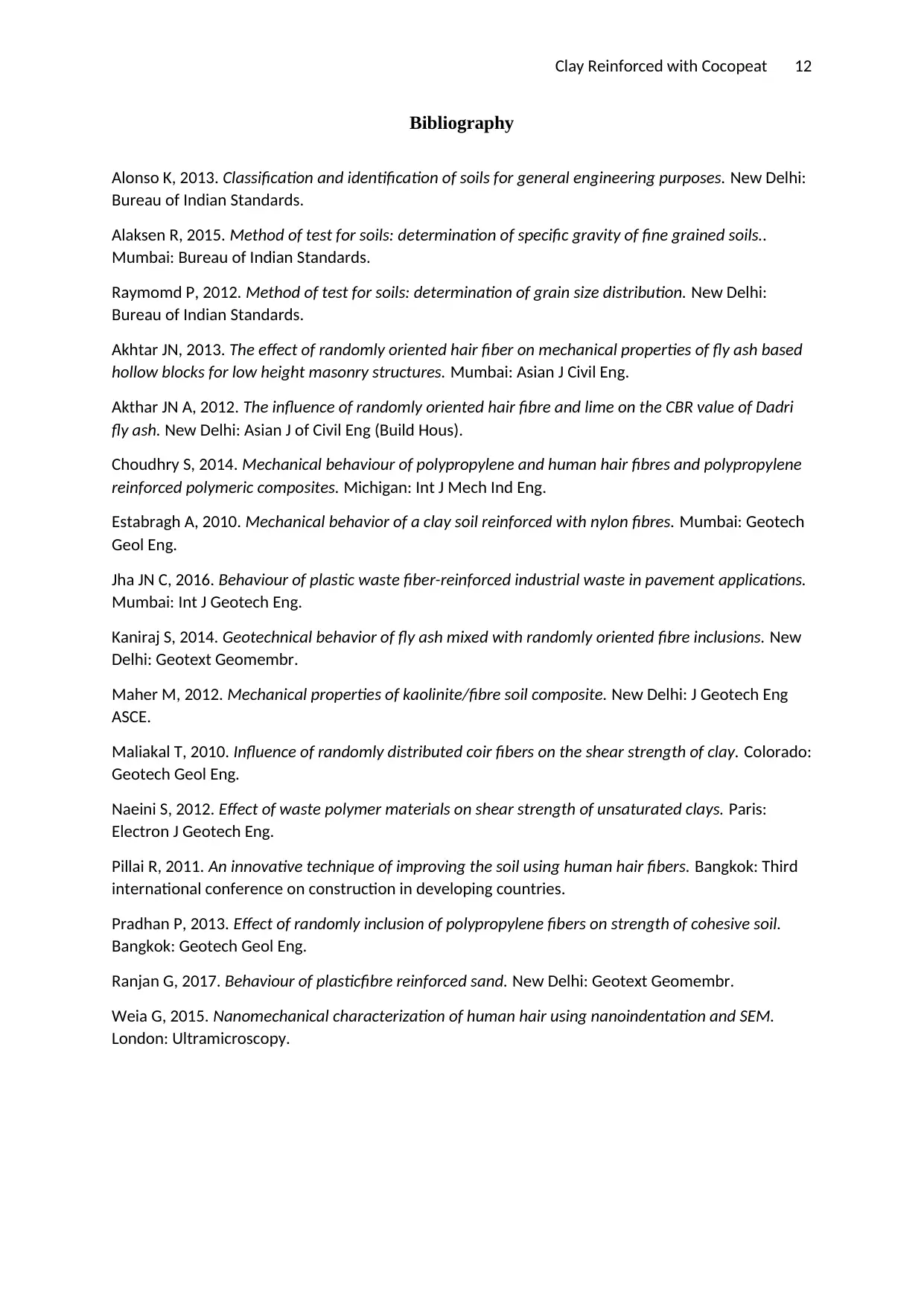
Clay Reinforced with Cocopeat 12
Bibliography
Alonso K, 2013. Classification and identification of soils for general engineering purposes. New Delhi:
Bureau of Indian Standards.
Alaksen R, 2015. Method of test for soils: determination of specific gravity of fine grained soils..
Mumbai: Bureau of Indian Standards.
Raymomd P, 2012. Method of test for soils: determination of grain size distribution. New Delhi:
Bureau of Indian Standards.
Akhtar JN, 2013. The effect of randomly oriented hair fiber on mechanical properties of fly ash based
hollow blocks for low height masonry structures. Mumbai: Asian J Civil Eng.
Akthar JN A, 2012. The influence of randomly oriented hair fibre and lime on the CBR value of Dadri
fly ash. New Delhi: Asian J of Civil Eng (Build Hous).
Choudhry S, 2014. Mechanical behaviour of polypropylene and human hair fibres and polypropylene
reinforced polymeric composites. Michigan: Int J Mech Ind Eng.
Estabragh A, 2010. Mechanical behavior of a clay soil reinforced with nylon fibres. Mumbai: Geotech
Geol Eng.
Jha JN C, 2016. Behaviour of plastic waste fiber-reinforced industrial waste in pavement applications.
Mumbai: Int J Geotech Eng.
Kaniraj S, 2014. Geotechnical behavior of fly ash mixed with randomly oriented fibre inclusions. New
Delhi: Geotext Geomembr.
Maher M, 2012. Mechanical properties of kaolinite/fibre soil composite. New Delhi: J Geotech Eng
ASCE.
Maliakal T, 2010. Influence of randomly distributed coir fibers on the shear strength of clay. Colorado:
Geotech Geol Eng.
Naeini S, 2012. Effect of waste polymer materials on shear strength of unsaturated clays. Paris:
Electron J Geotech Eng.
Pillai R, 2011. An innovative technique of improving the soil using human hair fibers. Bangkok: Third
international conference on construction in developing countries.
Pradhan P, 2013. Effect of randomly inclusion of polypropylene fibers on strength of cohesive soil.
Bangkok: Geotech Geol Eng.
Ranjan G, 2017. Behaviour of plasticfibre reinforced sand. New Delhi: Geotext Geomembr.
Weia G, 2015. Nanomechanical characterization of human hair using nanoindentation and SEM.
London: Ultramicroscopy.
Bibliography
Alonso K, 2013. Classification and identification of soils for general engineering purposes. New Delhi:
Bureau of Indian Standards.
Alaksen R, 2015. Method of test for soils: determination of specific gravity of fine grained soils..
Mumbai: Bureau of Indian Standards.
Raymomd P, 2012. Method of test for soils: determination of grain size distribution. New Delhi:
Bureau of Indian Standards.
Akhtar JN, 2013. The effect of randomly oriented hair fiber on mechanical properties of fly ash based
hollow blocks for low height masonry structures. Mumbai: Asian J Civil Eng.
Akthar JN A, 2012. The influence of randomly oriented hair fibre and lime on the CBR value of Dadri
fly ash. New Delhi: Asian J of Civil Eng (Build Hous).
Choudhry S, 2014. Mechanical behaviour of polypropylene and human hair fibres and polypropylene
reinforced polymeric composites. Michigan: Int J Mech Ind Eng.
Estabragh A, 2010. Mechanical behavior of a clay soil reinforced with nylon fibres. Mumbai: Geotech
Geol Eng.
Jha JN C, 2016. Behaviour of plastic waste fiber-reinforced industrial waste in pavement applications.
Mumbai: Int J Geotech Eng.
Kaniraj S, 2014. Geotechnical behavior of fly ash mixed with randomly oriented fibre inclusions. New
Delhi: Geotext Geomembr.
Maher M, 2012. Mechanical properties of kaolinite/fibre soil composite. New Delhi: J Geotech Eng
ASCE.
Maliakal T, 2010. Influence of randomly distributed coir fibers on the shear strength of clay. Colorado:
Geotech Geol Eng.
Naeini S, 2012. Effect of waste polymer materials on shear strength of unsaturated clays. Paris:
Electron J Geotech Eng.
Pillai R, 2011. An innovative technique of improving the soil using human hair fibers. Bangkok: Third
international conference on construction in developing countries.
Pradhan P, 2013. Effect of randomly inclusion of polypropylene fibers on strength of cohesive soil.
Bangkok: Geotech Geol Eng.
Ranjan G, 2017. Behaviour of plasticfibre reinforced sand. New Delhi: Geotext Geomembr.
Weia G, 2015. Nanomechanical characterization of human hair using nanoindentation and SEM.
London: Ultramicroscopy.
⊘ This is a preview!⊘
Do you want full access?
Subscribe today to unlock all pages.

Trusted by 1+ million students worldwide
1 out of 13
Related Documents
Your All-in-One AI-Powered Toolkit for Academic Success.
+13062052269
info@desklib.com
Available 24*7 on WhatsApp / Email
![[object Object]](/_next/static/media/star-bottom.7253800d.svg)
Unlock your academic potential
Copyright © 2020–2025 A2Z Services. All Rights Reserved. Developed and managed by ZUCOL.





